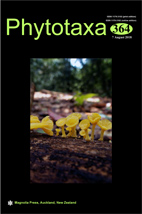Abstract
Gomphrena Linnaeus (1753: 224) (Gomphrenoideae Schinz, Amaranthaceae Juss.) is a genus including about 120 species, with center of diversity in the New World, and higher species richness in Central Andes, in argentinean and bolivian Puna, and Caatinga, and Cerrado habitats in Brazil (see e.g., Muller & Borsch 2005; Sánchez del Pino et al. 2009).
References
<p class="Reference">Bena, M.J. (2017) Typification and nomenclatural notes on twenty-seven names of <em>Gomphrena</em> L. (Amaranthaceae) linked to the South American flora. <em>Phytotaxa</em> 296 (2): 131–146.</p><p class="Reference"> https://doi.org/10.11646/phytotaxa.296.2.3</p><p class="Reference">Grimé, W.E. & Plowman, T. (1986) Type photographs at Field Museum of Natural History. <em>Taxon </em>35 (4): 932–934.</p><p class="Reference">Hiepko, P. (1987) The collections of the Botanical Museum Berlin-Dahlem (B) and their history. <em>Englera</em> 7: 219–252.</p><p class="Reference">Iamonico, D. (2012) Proposal to reject the name <em>Gomphrena polygonoides</em> (Amaranthaceae). <em>Taxon </em>61 (6): 1326–1327.</p><p class="Reference">Iamonico, D. & Sánchez Del Pino, I. (2014)<em> </em>Lectotypification of the Linnaean name <em>Gomphrena vermicularis</em> L. (<em>Amaranthaceae</em>). <em>Taxon </em>63 (2): 403–404.</p><p class="Reference"> https://doi.org/10.12705/632.4</p><p class="Reference">Linnaeus, C. (1753) <em>Species Plantarum</em>, vol. 1. Laurentius Salvius, Stockholm, 560 pp.</p><p class="Reference">Moquin-Tandon, C.H.B.A. (1849) Ordo Amarantaceae. <em>In</em>: Candolle, A. de (Ed.) <em>Prodromus Systematis Regni Vegetabilis</em>, vol. 13(2). Sumptibus Victois Masson, Parisiis, pp. 231–424.</p><p class="Reference">Müller, K. & Borsch, T. (2005) Phylogenetics of Amaranthaceae based on matK/trnK Sequence Data: evidence from parsimony, likelihood, and bayesian analyses. <em>Annals of the Missouri Botanical Garden</em> 92 (1): 66–102. </p><p class="Reference">Pedersen, T.M. (1987) Amaranthaceae Juss. <em>In</em>: Burkart, A., Troncoso, N. & Bacigalupo, N. (Eds.) <em>Flora ilustrada de Entre Ríos</em>, Tomo 4 (3). INTA, Buenos Aires, pp. 160–203.</p><p class="Reference">Pedersen, T.M. (1997) Studies in South American Amaranthaceae. IV. <em>Adansonia</em> 19 (2): 217–251.</p><p class="Reference">Ramella, L. (2016) Nomenclatura, tipificaciones y sinónimos nuevos en la familia Amaranthaceae de la Flora del Paraguay. <em>Candollea</em> 71 (2): 311–326.</p><p class="Reference"> https://doi.org/10.15553/c2016v712a16</p><p class="Reference">Sanchez del Pino, I., Borsch, T. & Motley, T.J. (2009) trnL-F and rpl16 Sequence Data and dense taxon sampling reveal monophyly of unilocular anthered Gomphrenoideae (Amaranthaceae) and an improved picture of their internal relationships. <em>Systematic Botany</em> 34 (1): 57–67.</p><p class="Reference"> https://doi.org/10.1600/036364409787602401</p><p class="Reference">Seubert, M. (1875) Amarantaceae Juss. <em>In</em>: Martius, C.F.P. & Eichler, A.W. (Eds.) <em>Flora Brasilensis</em>, vol. 5(1) [fasc. 68]. Frid. Fleischer, Lipsiae, Frid. Fleischer, pp. 161–252 + tab. 50–75.</p><p class="Reference">Stafleu, F.A. & Cowan, R.S. (1979) <em>Taxonomic Literature. A selective guide to botanical publications and collections with dates, commentaries and types, 2<sup>nd</sup> ed.</em>, vol. 2. H-Le. Bohn, Scheltema & Holkema, Utrecht.</p><p class="Reference">Townsend, C.C. (1993) Amaranthaceae. <em>In</em>: Kubitzki, K., Rohwer, J.G. & Bittrich, V. (Eds.) <em>The families and genera of vascular plants</em>, vol. 2. Springer, Berlin. pp. 70–91.</p><p class="Reference"> https://doi.org/10.1007/978-3-662-02899-5_7</p><p class="Reference">Turland, N.J., Wiersema, J.H., Barrie, F.R., Greuter, W., Hawksworth, D.L., Herendeen, P.S., Knapp, S., Kusber, W.-H., Li, D.-Z., Marhold, K., May, T.W., McNeill, J., Monro, A.M., Prado, J., Price, M.J. & Smith, G.F. (Eds.) (2018) <em>International Code of Nomenclature for algae, fungi, and plants (Shenzhen Code).</em> <em>adopted by the Nineteenth International Botanical Congress, Shenzhen, China, July 2017</em>. <em>Regnum Vegetabile</em> 159: 1–254.</p><p class="Reference"> https://doi.org/10.12705/Code.2018</p>

